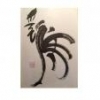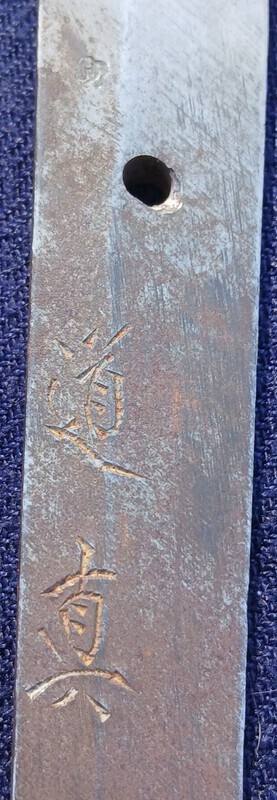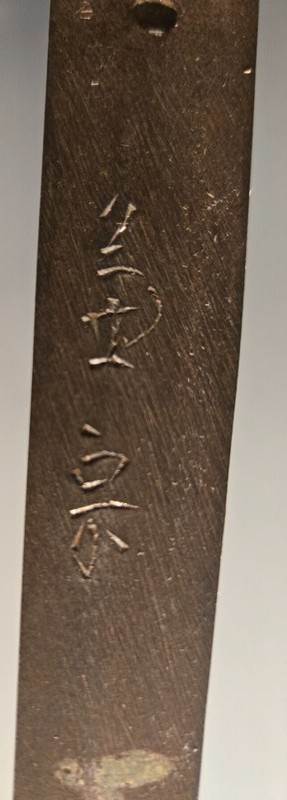-
Posts
905 -
Joined
-
Last visited
-
Days Won
14
Content Type
Profiles
Forums
Events
Store
Downloads
Gallery
Everything posted by mecox
-
Currently on hold
-
Type : Chigo-zashi (boys formal sword) in tachi style. Also called “chigo-to”. Ubu: all original Mei: Ietsugu Age : considered to be Taisho/early Showa Koshirae : in full original tachi koshirae of ito-maki style in green, total length is 67 cm. The kodogu all have matching engraved design, tsuba is tachi-style aoi-gata shape, has two engraved dragons each side and looks to be made of lead. Two matched pairs of seppa. Tsuka is well bound with quality same and has matched copper menuki (may be ceremonial bow and bag design). Saya has interesting brown lacquer with imbedded flake in good condition. Habaki is copper, one-piece well made with diagonal filing design. Nagasa : 38.5 cm. Sori : 1.8 cm Motohaba: 2.3 cm Nakago: length 10.7 cm, yasurime is sujikai, tip is katayama-gata typical for Kaga province. Hamon Type : suguha Jihada : not obvious Flaws : fine tate-ware. Description: Sword has a forged iron blade of good shape but basic manufacture. It is polished but not well finished. Suguha hamon is also basic although appears to have nioi sections. The sword overall is a well proportioned small scale tachi and in very good original condition. The ni-ji mei of IETSUGU 家次 is well cut on katana-mei. (There was a prominent line of Ietsugu tosho in Kaga Province in the late Koto and into the Shinto period, but this name not reported in modern times). The style of this sword is probably not for “Boys Day” but is for the older samurai tradition of the young son attending a festival, and these mounts are also called Iwai-zashi (“worn to the fesitival”). No sword stand is not included. Sword Location : Brisbane, Australia Will ship to : most locations Payment Methods Accepted : Paypal SOLD
-
Kumazawa Kanetoshi looks to use the go Seikosai, born Meiji 32 (1899) April 20, registered as a Seki smith on Showa 17 (1942) October 21, living in Seki-machi, Kifune-cho.
-
Mei: Naosuke. date Showa 19 (1944) January. Probably Seki smith Noguchi Kenichi Naosuke, born Taisho 8 (1919) January 14 and registered as a Seki smith Showa 18 (1943) Dec 11. Does this have any stamps?
-
@Bruce Pennington @Joseph P. there looks to be an error in the Sesko list with two smiths (from original Seki list): Made in November 1944. I think you have the name right. Sesko lists 2 by that name working during the war: "MICHIZANE (道真), Shōwa (昭和, 1926-1989), Gifu – “Michizane” (道真), real name Kosaka Takao (小坂隆男), born February 20th 1921, he worked as guntō smith and died December 17th 1964 MICHIZANE (道真), Shōwa (昭和, 1926-1989), Gifu – “Michizane” (道真), family name Nagao (長尾), he worked as guntō smith, ryōkō no retsu (Akihide) There is only one MICHIZANE and his real name was NAGAO TAKAO 道真 長尾 隆男 born Taisho 10 (1921) February 20, registered as a Seki smith on Showa 16 (1941) August 7. He was a student of Asano Kanezane. In 1942 Banzuke (Akihide) listed as Nagao Michizane. Looks to be also read as MICHISANE, but more likely "zane" is correct as a student of "Kanezane". These NOSHU examples with Sho stamp look to be katana-mei and well made Showato. Your blade is later war Nov 1944 and as noted through Nagoya Arsenal with small Seki stamp and Gifu stamp. Also is signed tachi-mei and in rinji seishiki koshirae. "Zane" is cut slightly different.
-
Joseph & Bruce, well I give up. He is an early war Seki smith. Can read: Seki ju Kawa # Kane # saku. Plus Sho stamp. So family name of Kawa # (looks a bit like Kawasaki). Tosho name of Kane # ( looks a bit like Kanemune or Kaneizumi?). Its beyond me. Possibly unregistered, but has a stamp. Need to get the expert @Nobody
-
Gracja, this is probably a very early war sword made in Seki. The nakago (hilt) is badly rusted, and there are probably some extra kanji further up. It is likely to be: 濃州関住二十三代藤原兼房作之 Noshu Seki ju Nijusan Dai Fujiwara Kanefusa saku kore "Fujiwara Kanefusa 23rd generation of Seki, Mino (Noshu) made this. His family name was Kato and given name Koichi. A good quality smith. Maybe hidden up under the tsuba is a stamp (maybe a sakura flower?).
-
As noted Ido Hidetoshi, a competent Seki smith in the Amahide workshop. Examples and his background in this NMB Download:
-

Not Kanezane, not Kanemichi - Who?
mecox replied to Bruce Pennington's topic in Translation Assistance
Looks like "Kanenao saku". There was a productive Seki gunto smith Ishihara Kanenao, but this mei is very different, but is very roughly cut. -
As above Fukumoto Kanemune of Amahide workshop. Showa 18 (1943) September. Looks to have a small "na" stamp for Nagoya Arsenal. For this workshop go to NMB Downloads, Member Articles, find Amahide.
-

Can someone please help me identify this sword.?
mecox replied to NikkiK's topic in Translation Assistance
Nicolette, as noted above it is a WW2 blade by a Seki smith called Kanefusa. You can find a summary of him and the context in NMB Downloads as "Japanese SWORDSMITHS IN GIFU 1937. Go to top of page bar, Downloads, Member Articles. Looks like the only part of the fittings that is original is the wooden saya with the suspension ring. The cane wrap is later. -
The book by Chris Bowen was published in 2017 and released in association with US Japanese Sword Club-Midwest. Book condition is not an issue. Thanks Mal Cox
-

Kanekuni Swordsmiths of Seki Ogawa & Tokyo Kato Families
mecox replied to mecox's topic in Military Swords of Japan
Well I have not seen your sword, and he did die in 1939, but I was going on the way the Kane-kuni is cut. Looks to me also the one in Slough p. 45. -

Kanekuni Swordsmiths of Seki Ogawa & Tokyo Kato Families
mecox replied to mecox's topic in Military Swords of Japan
Nicholas, your blade looks like Ogawa Sentaro Kanekuni. -

Kanekuni Swordsmiths of Seki Ogawa & Tokyo Kato Families
mecox replied to mecox's topic in Military Swords of Japan
Thanks Thomas, will incorporate. As a note: Chris Bowen contacted me finding a few "errors". I had got info from him, but this seems extra. I have asked Brian to withdraw the paper now, so I can correct it. -
This summary attempts to clarify the variation in kanji used for Showa period tosho namde KANEKUNI and the duplicate use of family name OGAWA by different Seki smiths. These variations can be confusing in the translated literature, especially the kanji for “Kuni”. Hopefully, there are no errors in this paper! Available in NMB Downloads:
-
Probably is Ishin Shiro Sadahiro, born Taisho 14 (1924) March 12, registered as Seki smith Showa 16 (1941) April 11. Also looks to have a Seki stamp.
-
Yes as noted looks to be Seki smith Noguchi NAOSUKE born 1919 and Seki registered December 1943.
-

For sale (B): gunto tsuba, kabutogane, fuchi, menuki
mecox replied to mecox's topic in Fittings/Tosogu/Kodogu/Koshirae
Dropped price to AUD 125 (approx US$ 97) plus shipping AUD 30 (US$19). -
Kevin, more background (from the Sesko lists): UJINOBU (氏信), 1st gen., Daiei (大永, 1521-1528), Mino – “Ujinobu Ganmaku” (氏信岩捲), “Nōshū Ganmaku Ujinobu” (濃州岩捲氏信), “Ganmaku” (岩捲), “Kiyomizu-jū Ujinobu” (清水住氏信), “Nōshū-jū Ganmaku” (濃州住岩捲), he lived in Mino´s Kiyomizu (清水), was a later smith of the Jumyō lineage (寿命), and the most representative smith of the Ganmaku group, somewhat standing-out itame mixed with masame, gunome-midare in ko-nie-deki with sunagashi, partially some dark areas appear in the ha, he was active until around Tenbun (天文, 1532-1555) UJINOBU (氏信), 2nd gen., Genki (元亀, 1570-1573), Mino – “Nōshū Kiyomizu-jū Ganmaku Ujinobu” (濃州清水住岩捲氏信), “Ganmaku Ujinobu” (岩捲氏信), “Ujinobu” (氏信), gunome-midare in ko-nie-deki, some blades show horimono, wazamono, chū-saku UJINOBU (氏信), 3rd gen., Keichō (慶長, 1596-1615), Mino – “Nōshū Kiyomizu-jū Ganmaku” (濃州清水住岩捲), “Kiyomizu-jū Ganmaku” (清水住岩捲), Ujinobu” (氏信), it is said that he bore the priest rank of a hokkyō (法橋), successive generations Ujinobu moved around Kanbun (寛文, 1661-1673) and Tenna (天和, 1681-1684) to Owari province
-

ARMY MOUNT ARMY MOUNT 27 3/8" KANEHIRO ?
mecox replied to Dogditcher's topic in Military Swords of Japan
Matsuda Kanetaka was an early wartime smith in Seki, born 1911 and registered 1939 October. See info in paper on Swordsmiths in Gifu 1939 in NMB Downloads (link at top of page under Downloads, Members Articles) -
Looks like Ganmaku, more from Sesko to check: GANMAKU (岩捲), Eiroku (永禄, 1558-1570), Mino – “Ganmaku” (岩捲), “Nōshū Kiyomizu-jū Ganmaku” (濃州清水住岩捲), he was a late Jumyō smith (寿命) who lived Kiyomizu (清水) in the Ibi district (揖斐) of Mino province, the Ganmaku group included several smiths who all signed with this name, some sources consider the 1st gen. Ujisada as founder of the Ganmaku group, see also entry “UJISADA (氏貞), 1st gen., Daiei (大永, 1521-1528), Mino,” the more commonly accepted theory says that Ujinobu (氏信) was the founder of this group because the Ujinobu smiths often signed with the supplement Ganmaku, see also entry “UJINOBU (氏信), 1st gen., Daiei (大永, 1521-1528), Mino” GANMAKU (岩捲), Kanbun (寛文, 1661-1673), Mino – “Nōshū Shimizu-jū Ganmaku” (濃州清水住岩捲), some sources list him with the characters (岩騫) for “Ganmaku,” mokume, gunome-midare, chū-suguha, chūjō-saku
-

ARMY MOUNT 27 5/8" TADAKUNI MASAHIRO ?
mecox replied to Dogditcher's topic in Military Swords of Japan
Hizen ju Harima .....and shortened. It could be the following (from Sesko): Note the kanji for "ma" is unusual, plus hamon of various choji. But I am not sure. TADAKUNI (忠国), 1st gen., Keian (慶安, 1648-1652), Hizen – “Hizen-jū Harima no Daijō Fujiwara Tadakuni” (肥前住播摩大掾藤原忠国), “Harima no Daijō Fujiwara Tadakuni” (播磨大掾藤原忠国), “Hishū-jū Harima Nyūdō Fujiwara Kyūtetsu” (肥州播摩入道藤原休鉄), “Harima Nyūdō Fujiwara Kyūtetsu” (播磨入道藤原休鉄), the 1st gen. Tadakuni was born in Keichō three (慶長, 1598) as second son Hirosada (広貞) who changed his name later to Yoshiie (吉家), real name Hashimoto Rokurōzaemon (橋本六郎左衛門), he signed first with Hironori (広則) but changed his name with receiving the honorary title Harima no Daijō in Kan´ei eleven (寛永, 1634) to Tadakuni (忠国), his nyūdō-gō was Kyūtetsu (休鉄) and he died on the 22nd day of the fourth month Genroku four (元禄, 1691) at the age of 94, dense and standing-out ko-itame with ji-nie all over the blade which appears as konuka-hada, the hamon is mostly a flamboyant and excellently tempered chōji-midare or gunome-chōji, but also a chū-suguha is found, during his early years he signed the character “ma” (磨) in “Harima” (播磨) with the variant (摩), it seems that he changed towards the common way of writing at some time during the Shōhō era (正保, 1644-1648), in later years he returned to (摩), some say that all blades signed with the variant (磨) are actually daisaku-daimei works of the 2nd gen. but this can´t be proofed, wazamono, jō-saku -
HIZUKE NO HON Malcolm and Sueko Cox Printed 2007 (now updated copies) The aim of this book is to help reading Japanese dates on swords. It shows different systems, types of signature (mei), list of nengo with kanji, map of provinces, and explanation of zodiac date system. The book contains tables of dates from 1000 to 2028 (Reiwa 10), with nengo, western year, zodiac and other cycles. Ways of writing dates are summarised also key events of Japanese (sword) history. It has 26 full page of oshigata from 1186 to 1943, with mei and dates in Romaji and kanji. Book is soft cover, 29 x 20.5 cm, 75 pages in length. The book will be of particular use to new folk to the study, plus mature followers whose recall capacities are fading (I use it regularly!). Book is AUD20 with airmail to USA of AUD28 (total AUD48 approx. US$30).
-
- 3
-

-
Noshu ju Murayama Kaneshige saku, Seki, born Meiji 42 (1909) July. There are several Kaneshige. This is in Slough p. 64-65







